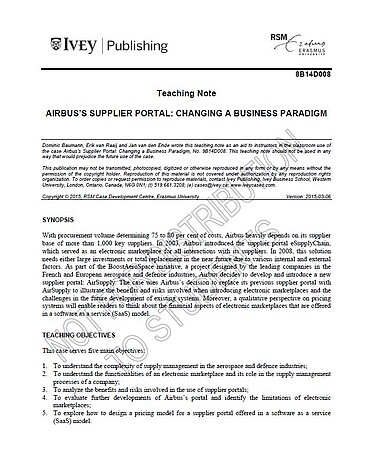description
With procurement volume determining 75 to 80 per cent of costs, Airbus heavily depends on its 1,000 or more key suppliers. As a solution to the complexity of its supply chain, it introduced a portal to serve as an electronic marketplace for all interactions with its suppliers. Five years have passed: this portal either needs large investments or total replacement in the near future. What should Airbus do and how?
Citation Note
Based on field research; 14 pages.
Follow the 'handle' link to access the Case Study on RePub.
For EUR staff members: the Teaching Note is available on request, you can contact us at rsm.nl/cdc/contact/
For external users: follow the link to purchase the Case Study and the Teaching Note.
Objective
This case is suitable for undergraduate and graduate students of economics, strategy and supply chain management. It can be used in courses or training on supply management or strategy in general. This case serves five main objectives: 1. To understand the complexity of supply management in the aerospace and defence industries. 2. To understand the functionalities of an electronic marketplace and its role in the supply management processes of a company. 3. To analyse the benefits and risks involved in the use of supplier portals. 4. To evaluate further developments of Airbus’s portal and identify the limitations of electronic marketplaces. 5. To explore how to design a pricing model for a supplier portal offered in an SaaS model.
usage
MBA/Postgraduate
Abstract
With procurement volume determining 75 to 80 per cent of costs, Airbus heavily depends on its supplier base of more than 1,000 key suppliers. In 2003, Airbus introduced the supplier portal eSupplyChain, which served as an electronic marketplace for all interactions with its suppliers. In 2008, this solution needs either large investments or total replacement in the near future due to various internal and external factors. As part of the BoostAeroSpace initiative, a project designed by the leading companies in the French and European aerospace and defence industries, Airbus decides to develop and introduce a new supplier portal: AirSupply. The case uses Airbus’s decision to replace its previous supplier portal with AirSupply to illustrate the benefits and risks involved when introducing electronic marketplaces and the challenges in the future development of existing systems. Moreover, a qualitative perspective on pricing systems will enable readers to think about the financial aspects of electronic marketplaces that are offered in a software as a service (SaaS) model.
